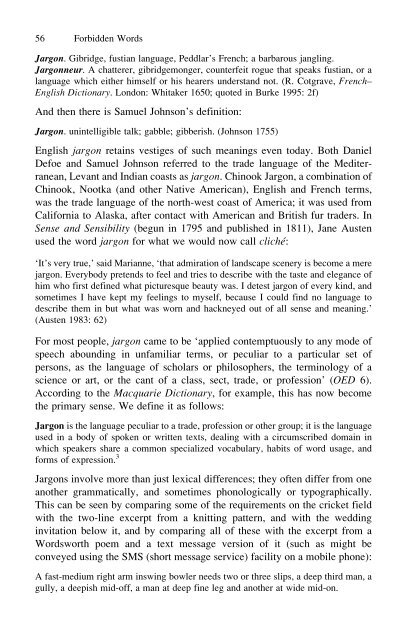Forbidden Words: Taboo and the Censoring of Language
Forbidden Words: Taboo and the Censoring of Language
Forbidden Words: Taboo and the Censoring of Language
You also want an ePaper? Increase the reach of your titles
YUMPU automatically turns print PDFs into web optimized ePapers that Google loves.
56 <strong>Forbidden</strong> <strong>Words</strong><br />
Jargon. Gibridge, fustian language, Peddlar’s French; a barbarous jangling.<br />
Jargonneur. A chatterer, gibridgemonger, counterfeit rogue that speaks fustian, or a<br />
language which ei<strong>the</strong>r himself or his hearers underst<strong>and</strong> not. (R. Cotgrave, French–<br />
English Dictionary. London: Whitaker 1650; quoted in Burke 1995: 2f)<br />
And <strong>the</strong>n <strong>the</strong>re is Samuel Johnson’s definition:<br />
Jargon. unintelligible talk; gabble; gibberish. (Johnson 1755)<br />
English jargon retains vestiges <strong>of</strong> such meanings even today. Both Daniel<br />
Defoe <strong>and</strong> Samuel Johnson referred to <strong>the</strong> trade language <strong>of</strong> <strong>the</strong> Mediterranean,<br />
Levant <strong>and</strong> Indian coasts as jargon. Chinook Jargon, a combination <strong>of</strong><br />
Chinook, Nootka (<strong>and</strong> o<strong>the</strong>r Native American), English <strong>and</strong> French terms,<br />
was <strong>the</strong> trade language <strong>of</strong> <strong>the</strong> north-west coast <strong>of</strong> America; it was used from<br />
California to Alaska, after contact with American <strong>and</strong> British fur traders. In<br />
Sense <strong>and</strong> Sensibility (begun in 1795 <strong>and</strong> published in 1811), Jane Austen<br />
used <strong>the</strong> word jargon for what we would now call cliché:<br />
‘It’s very true,’ said Marianne, ‘that admiration <strong>of</strong> l<strong>and</strong>scape scenery is become a mere<br />
jargon. Everybody pretends to feel <strong>and</strong> tries to describe with <strong>the</strong> taste <strong>and</strong> elegance <strong>of</strong><br />
him who first defined what picturesque beauty was. I detest jargon <strong>of</strong> every kind, <strong>and</strong><br />
sometimes I have kept my feelings to myself, because I could find no language to<br />
describe <strong>the</strong>m in but what was worn <strong>and</strong> hackneyed out <strong>of</strong> all sense <strong>and</strong> meaning.’<br />
(Austen 1983: 62)<br />
For most people, jargon came to be ‘applied contemptuously to any mode <strong>of</strong><br />
speech abounding in unfamiliar terms, or peculiar to a particular set <strong>of</strong><br />
persons, as <strong>the</strong> language <strong>of</strong> scholars or philosophers, <strong>the</strong> terminology <strong>of</strong> a<br />
science or art, or <strong>the</strong> cant <strong>of</strong> a class, sect, trade, or pr<strong>of</strong>ession’ (OED 6).<br />
According to <strong>the</strong> Macquarie Dictionary, for example, this has now become<br />
<strong>the</strong> primary sense. We define it as follows:<br />
Jargon is <strong>the</strong> language peculiar to a trade, pr<strong>of</strong>ession or o<strong>the</strong>r group; it is <strong>the</strong> language<br />
used in a body <strong>of</strong> spoken or written texts, dealing with a circumscribed domain in<br />
which speakers share a common specialized vocabulary, habits <strong>of</strong> word usage, <strong>and</strong><br />
forms <strong>of</strong> expression. 3<br />
Jargons involve more than just lexical differences; <strong>the</strong>y <strong>of</strong>ten differ from one<br />
ano<strong>the</strong>r grammatically, <strong>and</strong> sometimes phonologically or typographically.<br />
This can be seen by comparing some <strong>of</strong> <strong>the</strong> requirements on <strong>the</strong> cricket field<br />
with <strong>the</strong> two-line excerpt from a knitting pattern, <strong>and</strong> with <strong>the</strong> wedding<br />
invitation below it, <strong>and</strong> by comparing all <strong>of</strong> <strong>the</strong>se with <strong>the</strong> excerpt from a<br />
<strong>Words</strong>worth poem <strong>and</strong> a text message version <strong>of</strong> it (such as might be<br />
conveyed using <strong>the</strong> SMS (short message service) facility on a mobile phone):<br />
A fast-medium right arm inswing bowler needs two or three slips, a deep third man, a<br />
gully, a deepish mid-<strong>of</strong>f, a man at deep fine leg <strong>and</strong> ano<strong>the</strong>r at wide mid-on.

















